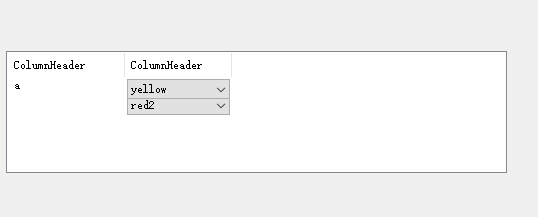
using System;
using System.Collections.Generic;
using System.ComponentModel;
using System.Data;
using System.Drawing;
using System.Linq;
using System.Text;
using System.Threading.Tasks;
using System.Windows.Forms;
namespace WindowsFormsAppTest
{
public partial class ListViewxc : ListView
{
private List<Control> controlsxc = new List<Control>();
private const int WM_PAINT = 0x000F;
public ListViewxc()
{
InitializeComponent();
controlsxc.Clear();
this.OwnerDraw = true;
this.DrawColumnHeader += new DrawListViewColumnHeaderEventHandler(this_DrawColumnHeader);
this.DrawSubItem += new DrawListViewSubItemEventHandler(this_DrawSubItem);
}
protected override void OnPaint(PaintEventArgs e)
{
foreach (Control item in controlsxc)
{
ListViewSubItemxc subItemxc = item.Tag as ListViewSubItemxc;
if (subItemxc != null)
{
Rectangle r = subItemxc.Bounds;
ComboBox combox = item as ComboBox;
if (combox != null)
{
if (r.Y > 0 && r.Y < this.ClientRectangle.Height)
{
combox.Visible = true;
combox.Bounds = new Rectangle(r.X + 2, r.Y + 2, r.Width - (2 * 2), r.Height - (2 * 2));
System.Diagnostics.Debug.WriteLine(",,," + r.X + " " + r.Y + " " + r.Width + " " + r.Height);
}
else
{
combox.Visible = false;
}
}
}
}
base.OnPaint(e);
}
protected override void WndProc(ref Message m)
{
if (m.Msg == WM_PAINT)
{
foreach (Control item in controlsxc)
{
ListViewSubItemxc subItemxc = item.Tag as ListViewSubItemxc;
if (subItemxc != null)
{
Rectangle r = subItemxc.Bounds;
ComboBox combox = item as ComboBox;
if (combox != null)
{
if (r.Y > 0 && r.Y < this.ClientRectangle.Height)
{
combox.Visible = true;
combox.Bounds = new Rectangle(r.X + 2, r.Y + 2, r.Width - (2 * 2), r.Height - (2 * 2));
System.Diagnostics.Debug.WriteLine(",,," + r.X + " " + r.Y + " " + r.Width + " " + r.Height);
}
else
{
combox.Visible = false;
}
}
}
}
}
base.WndProc(ref m);
}
private void this_DrawSubItem(object sender, DrawListViewSubItemEventArgs e)
{
e.DrawDefault = true;
}
private void this_DrawColumnHeader(object sender, DrawListViewColumnHeaderEventArgs e)
{
e.DrawDefault = true;
}
public void AddItemxc(ListViewItem item)
{
foreach (ListViewItem.ListViewSubItem it in item.SubItems)
{
ListViewSubItemxc x = it as ListViewSubItemxc;
if (x != null && x._control != null)
{
this.Controls.Add(x._control);
x._control.Tag = x;
ComboBox co = x._control as ComboBox;
if (co != null)
{
co.SelectedIndexChanged += Co_SelectedIndexChanged;
controlsxc.Add(co);
}
}
}
this.Items.Add(item);
}
private void Co_SelectedIndexChanged(object sender, EventArgs e)
{
ComboBox co = sender as ComboBox;
ListViewSubItemxc x = co.Tag as ListViewSubItemxc;
if (x != null)
{
x.Text = co.SelectedText;
}
}
}
public class ListViewSubItemxc : ListViewItem.ListViewSubItem
{
public Control _control = null;
public ListViewSubItemxc(Control con)
{
_control = con;
}
}
}
using System;
using System.Collections.Generic;
using System.ComponentModel;
using System.Data;
using System.Drawing;
using System.Linq;
using System.Text;
using System.Threading.Tasks;
using System.Windows.Forms;
namespace WindowsFormsAppTest
{
public partial class Form1 : Form
{
public Form1()
{
InitializeComponent();
}
private void Form1_Load(object sender, EventArgs e)
{
ListViewItem l = new ListViewItem();
l.Text = "a";
ComboBox cb = new ComboBox();
cb.DropDownStyle = ComboBoxStyle.DropDownList;
cb.Items.Add("yellow");
cb.Items.Add("red");
cb.SelectedIndex = 0;
ListViewSubItemxc lxc = new ListViewSubItemxc(cb);
ListViewItem l2 = new ListViewItem();
ComboBox cb2 = new ComboBox();
cb2.DropDownStyle = ComboBoxStyle.DropDownList;
cb2.Items.Add("yellow2");
cb2.Items.Add("red2");
cb2.SelectedIndex = 1;
ListViewSubItemxc lxc2 = new ListViewSubItemxc(cb2);
l.SubItems.Add(lxc);
l2.SubItems.Add(lxc2);
listViewxc1.AddItemxc(l);
listViewxc1.AddItemxc(l2);
}
}
}
